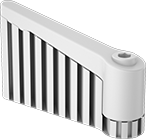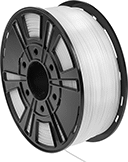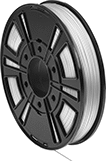About Plastic
More
Impact-Resistant PPSU



- Color: See Table
- Max. Temperature: 300° F
- Tensile Strength: 10,500 psi (Good)
- Impact Strength: 2.5 ft.-lbs./in. (Good)
- Hardness: Rockwell R120 (Hard)
- For Use Outdoors: No
- Specifications Met: ASTM D6394, FDA Compliant 21 CFR 177.1560, UL 94 V-0
Offering excellent resistance to shock, these PPSU rods are frequently fabricated into vehicle parts and machine components that are subject to vibration. They are easy to machine and thermoform, plus they maintain physical properties when heated, even through repeated autoclaving cycles.
| Dia. | Dia. Tolerance | Lengths, ft. | Per Ft. | |
Off-White | ||||
|---|---|---|---|---|
| 1/2" | 0.000" to 0.003" | 0000000 | 00000 | |
| 3/4" | 0.000" to 0.003" | 0000000 | 00000 | |
| 1" | 0.000" to 0.003" | 0000000 | 00000 | |
Black | ||||
| 1/2" | 0.000" to 0.003" | 0000000 | 0000 | |
| 3/4" | 0.000" to 0.003" | 0000000 | 00000 | |
| 1" | 0.000" to 0.003" | 0000000 | 00000 | |
| 1 1/2" | 0.000" to 0.003" | 0000000 | 00000 | |
Amber | ||||
| 1 1/2" | 0.000" to 0.005" | 0000000 | 00000 | |
Structural Support 3D Printer Filaments

with your part to prevent the
part from losing its shape

When 3D printing a model with overhangs or hollow spaces, use these filaments to prevent the model from losing its shape. They support the structure during the printing and cooling process, then dissolve or snap away once the part is hardened. Use them in dual-extrusion fused filament fabrication (FFF) printers alongside your primary filament. Unlike parts with supports printed from a single filament, there’s no cutting, sanding, or polishing required.
Choose a filament that has similar printing requirements as your primary filament. You will want to choose a support filament that prints at a similar temperature as your primary filament and has the same requirements for a heated build chamber, so they cool at the same rate and won’t warp. Aquasys 180 filaments work with high-temperature plastic, such as PEEK, PEI, and PPS. They require a heated build chamber. PSU blend filaments work with high-temperature plastic, such as PEEK and PEI, and require a heated build chamber.
You should also consider how you will remove the structural support filament from your finished part. Soluble filaments are well suited to print parts with complex or fragile designs as they gently dissolve off your primary part, leaving a smooth finish. Water-soluble filaments dissolve in a heated bath. Break-away filaments are designed to cleanly snap off of your primary parts with your hands while the print is still warm, taking only minutes to fully remove.
Spool | ||||||||||||
|---|---|---|---|---|---|---|---|---|---|---|---|---|
| Dia., mm | Printing Temp. | For Printer Bed Temp. | Hardness | Max. Exposure Temp. | Water Temp. to Dissolve | For Min. Nozzle Opening Dia., mm | Dia., mm | Dp., mm | Wt., g | For Use With | Each | |
Water Soluble | ||||||||||||
Aquasys 180—Opaque Amber | ||||||||||||
| 1.75 | 230° to 300° C 446° to 572° F | 60° to 180° C 140° to 356° F | Not Rated | 70° C 158° F | 80° C 176° F | 0.4 | 200 | 55 | 500 | PEEK Plastic PEI Plastic PEKK Plastic PPS Plastic PPSU Plastic | 0000000 | 0000000 |
| 2.85 | 230° to 300° C 446° to 572° F | 60° to 180° C 140° to 356° F | Not Rated | 70° C 158° F | 80° C 176° F | 0.4 | 200 | 55 | 500 | PEEK Plastic PEI Plastic PEKK Plastic PPS Plastic PPSU Plastic | 0000000 | 000000 |
Break Away | ||||||||||||
PSU Blend—Clear | ||||||||||||
| 1.75 | 350° to 380° C 662° to 716° F | 120° to 160° C 248° to 320° F | Rockwell R125 (Hard) | 180° C 356° F | __ | 0.4 | 200 | 35 | 500 | PEEK Plastic PEI Plastic PEKK Plastic PPS Plastic PPSU Plastic PSU Plastic | 0000000 | 000000 |
Chemical-Resistant PPSU 3D Printer Filaments

Fabricate custom bottles, packaging, and other parts for chemical processing. Made of PPSU, these filaments won’t break down even after prolonged exposure to virtually any acid, base, or solvent. They also stand up to oil and fuel, so they’re sometimes made into automotive parts. Because they have a low density and won’t transfer electricity, they make parts that are lightweight and protect components from electric currents. These filaments are easy to store too, since they resist absorbing water. Rated UL 94 V-0, they meet flammability standards.
Print these filaments on a fused filament fabrication (FFF) 3D printer. Due to its high melting point, PPSU is more difficult to print than most other materials. You need an all-metal extruder and a heated printer bed to reach its minimum printing temperature. After printing, anneal your part in an oven for 2 to 4 hours to reach its maximum strength, temperature, and ability to resist chemicals.
Tensile strength is the best measure of a filament’s overall strength. Similar to the stress applied on a rope during a game of tug-of-war, it’s the amount of pulling force a material can handle before breaking. A higher rating means a stronger filament. A tensile strength of 5,000 psi and above is considered good; 12,000 psi and above is excellent.
Maximum exposure temperature is the point at which a printed part will begin to deform. Above this temperature, your part will start to lose structural integrity.
Spool | ||||||||||||
|---|---|---|---|---|---|---|---|---|---|---|---|---|
| Dia., mm | Printing Temp. | For Printer Bed Temp. | Tensile Strength | Annealing Temp. | Maximum Exposure Temperature | Specifications Met | For Min. Nozzle Opening Dia., mm | Dia., mm | Dp., mm | Wt., g | Each | |
PPSU Plastic | ||||||||||||
Off-White | ||||||||||||
| 1.75 | 390° to 410° C 734° to 770° F | 140° to 160° C 284° to 320° F | 7,970 psi (Good) | 80° to 130° C 176° to 266° F | 180° C 200° C | UL 94 V-0 | 0.4 | 200 | 40 | 500 | 000000 | 0000000 |





























